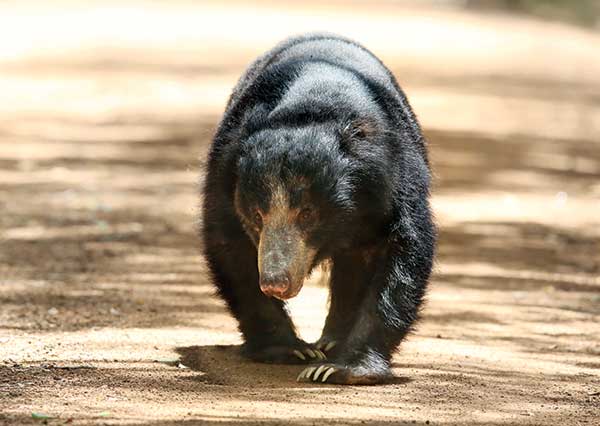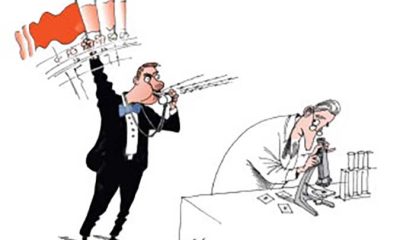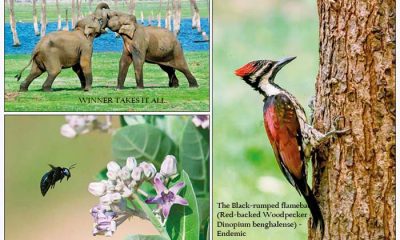Features
More on Wilpattu, natural systems and exotic flora
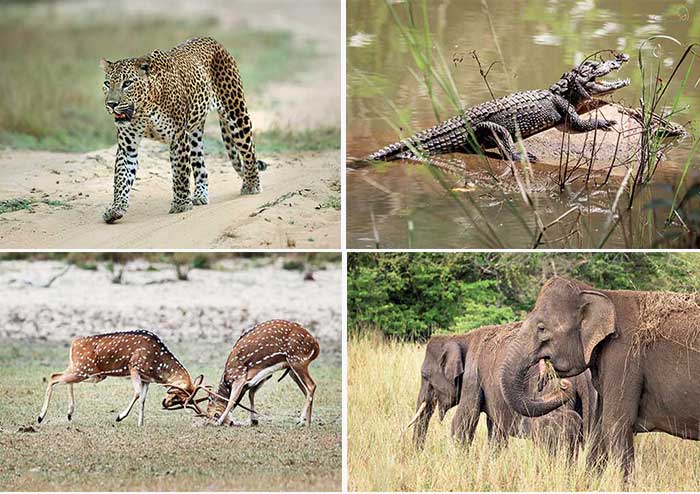
Excerpted from the authorized biography of Thilo Hoffmann
by Douglas B. Ranasinghe
During the years that followed 1985, the Park was closed and abandoned. Animals in it were slaughtered, especially buffaloes, wild pig, sambhur and deer. All the visitors’ and staff bungalows were ransacked and largely destroyed by roaming poachers, criminals and timber thieves.
In 2005 the Park was reopened, with a hardworking Park Warden, Wasantha Pushpananda. At his request and the urging of Geepal Fernando, Thilo spent nearly two million rupees on the reconstruction of the Talawila bungalow, in memory of his wife.
Only two years later the Park was again abandoned with the re-emergence of incursions from surrounding areas. Warden Pushpananda was killed. Again wildlife was depleted, and the re-built bungalows ransacked. After the fall of the LTTE, the Park was opened for visitors again in 2010. Once more, Thilo restored the bungalow.But pressure to open the coastal tract for through-traffic to Mannar persists. An easy alternative from Nochchiyagama via Nikawewa and Tantirimalai to Cheddikulam is ignored.
While this was being written, certain authorities have illegally and arbitrarily cut a new road along the coast within Wilpattu, and developed and opened for public use the Army road, damaging the ecology of the National Park on an unprecedented scale. The matter is being contested in court. Several conservation bodies, including the WNPS and Ceylon Bird Club – Thilo’s roles in these are described later – have been battling to uphold the law and save the Park. At their initial meeting and first press conference Thilo, now retired and in Sri Lanka for an annual stay of several months, was an invited speaker.
Natural systems and exotic flora
A `patana’ (sometimes anglicized as ‘patna’) is a grassland of Sri Lanka in the hills or mountains without trees or shrubs but typically intersected by sholas, described below. A `talawa’ is a savanna-type grassland with trees or groups of trees spaced some distance apart; these are mostly fire-resistant species. (Both are traditional Sri Lankan terms).
The afforestation of patanas and talawas with the exotic Pinus caribaea trees was a major point of contention between Thilo, representing the WNPS, and the Forest Department (the ‘FD’).
The FD claims that both patanas and talawas are man made systems whose lands had originally been under forest. Thus they misname the establishment of sterile pinus or eucalyptus plantations as “re-afforestation”. One Conservator of Forests had even proposed the “re-afforestation” of the open plains in the National Parks of the Yala complex, on the same reasoning. Thilo observes:
“When the advocates of pinus claim that under it indigenous species can freely develop, they think of infillings and plantings in degraded wet zone forests, e.g. around Sinharaja. Consider the biological (floral and faunal) composition of ‘dry patanas’ and talawas, and the indisputable fact that in both systems plants and other living organisms have evolved which are confined to these systems as their exclusive habitat.
“One example is the daffodil orchid (Ipsea speciosa) which is endemic to the patanas. It takes a very long time for a species to evolve and establish itself, wherefore the presence of endemics in a system is a strong indication that it is natural and not man-made. The existence of sholas also tends to support this view. It can further be assumed that prehistoric man at the relevant time had neither the means nor the need to clear such large areas permanently.
“By establishing the alien monocultures the FD has practically destroyed climax-type natural systems which only 50 years ago and for at least one hundred thousand years before have characterized the hill country, especially the Uva Plateau and the adjoining foothills.”
Against strong majority opinion, Thilo thus maintains that patanas, typically with sholas (see below), are a natural system, considering other factors, too, such as climate, soil conditions, exposure and topography – not man-made, although during the last three centuries selected patanas were seasonally burnt by the few thinly-spread inhabitants of the area.
Today there are few remnants of typical patanas and none of any sizeable extent. During the last half century patanas have been degraded and destroyed not only by the Forest Department but also through systematic State-sponsored settlement and the subsequent opening for cultivation of even the steepest slopes. The State has failed to recognize and appreciate patanas as a national system of value and to protect at least one typical and sufficiently large extent of these original grasslands. Patanas covered about 160,000 acres or 250 square miles (650 square km) of land, mainly in Uva.
Thilo condemns the establishment of pinus plantations not only because these destroy such natural systems and diversity but also for aesthetic reasons. He explains:
“There are no conifers native to Sri Lanka. Any plant belonging to the family with needles instead of leaves is a ‘double alien’ also because of its utterly out-of-place appearance in our scenery and environment. Pinus plantations alter the landscape massively – dark, nearly black, brooding patches in an otherwise bright and pleasant world.
“These are alien monocultures which exterminate the rich fauna and flora of the patanas and talawas. They might well be characterized as ‘man-propagated invasive foreign flora’, a term which has recently been much talked and written about. [See below.]”
Another important fact was overlooked, and seems to be largely unknown. Thilo points out that healthy, natural Sri Lankan forests do not catch fire even under extreme conditions. In order to clear the land the vegetation consisting of trees and undergrowth has to be felled and at least partly dried before a fire can be started.
Decades ago when he was traveling at night in the dry zone during the annual drought, dozens of chena plots would be ablaze, the fire having being fanned by the strong kachan wind. But when it was over, and only white ash remained, the surrounding forest at the very edge of the clearing was hardly singed, the fire being unable to spread.
On the other hand, pinus plantations, which are supposed to “re-afforest” the patanas, burn out easily and completely due to their resinous nature. All too often this happens. Thilo remembers this unique region as it was in his early years:
“In the late forties and the fifties of the last century the Uva Basin was very thinly populated. Traditional ways of life prevailed in much of the Uva Province; pack bulls were yet a common sight in its remoter parts.
“In the Uva Basin, large tracts of open patana covered most of the undulating area, with villages and paddy lands confined to and hidden in the river valleys. These patanas were then the main habitat of the painted partridge which is now restricted to a small area near Bibile. The endemic daffodil orchid was present in most of the Uva patanas, including those at Chelsea Estate and along the road from Bandarawela to Welimada.
“There were no forests except the so-called sholas, which are narrow strips of forest along the small water courses that have cut their way into the hillsides. These sholas are rich systems with many plant species and animals. Muntjac, mouse deer, pangolin, porcupine, hare and a great variety of birds found suitable habitats in them. Where patana and forest meet the dividing line is sharp, clearly defined and permanent; there is no “creeping” of the forest or shola in to the patana grasslands.”
(‘Shola’ is a word of Indian origin. With regard to the Uva plateau see also Thilo’s description in W.W.A. Phillips’s Handbook of the Mammals of Ceylon, Second edition, 1980.)
Early in the last century Bella Sidney Woolf, sister of Leonard, in her book How to See Ceylon aptly describes the Uva Plateau as “one of the great open spaces of the world that gives one a sense of freedom”. G. M. Henry, the ornithologist, who was active in Ceylon up to the middle of the last century refers to “the great Uva patna basin” in his publications. Today it is as cluttered up as most parts of Sri Lanka. Thilo says:
“At that time sholas were also present in many tea estates and were protected by law as stream reservations. Plantation managements strictly maintained these reservations, not only ensuring a high biodiversity in the hillsides, but also a regular supply of clean water for the villages in the valleys below and for their paddy fields.
“Later, as the political situation in Colombo changed and the population increased, these very useful and progressive reservations were gradually encroached upon and cleared by villagers and eventually disappeared, many being finally ‘regularized’ i.e. officially given to the illegal occupants.
“The result in many cases was scarcity of water in the villages, and often landslides. In the mid 20th century there were practically no landslides in Uva; today they occur regularly. The state then did nothing at all to enforce the law on these stream reservations, which still exists as a ‘dead letter’.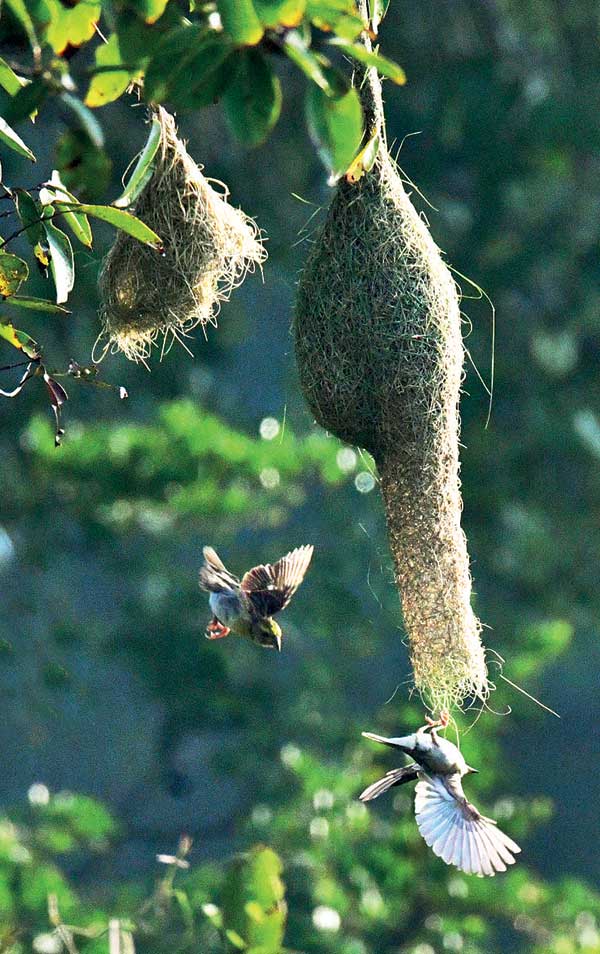
“Soon the Government also decided to settle people in the large extents of patana State land in Uva, and the Forest Department began to establish on the grassy slopes monoculture plantations of eucalyptus and pinus species. First as a trial at Palugama (now Keppetipola), and then on a large scale on every hillside in the area, they planted these exotic trees on the basis that the grasslands had originally been forest. These activities radically changed the character of the Uva Plateau, and today it bears no comparison to what it was in the 1930s to 1950s and historically.”
As an agronomist Thilo had soon noted that the soils of patana lands are shallow, gravelly, excessively drained, and very erodable if cleared of the original vegetation, especially the steep hillsides. The continuing clearing of such land is the opposite of development, and it has caused untold harm to the areas concerned.
Similarly, Thilo and the WNPS were not happy about the establishment of extensive teak and eucalyptus plantations in the dry zone where large extents of indigenous forest were cleared for the purpose.
In the intermediate and wet zone Thilo advocated afforestation with mixed mahogany and jak trees. This had been done during the Second World War when State forest was given out to private enterprise for the growing of papaya. He explains:
“This was for the production of papain, then a valuable export commodity in worldwide short supply during the war. The planting of the other trees together with the commercial crop was a condition. These mixed plantations allow the development of indigenous species amongst the jak and mahogany. They have formed marvellous and majestic forests, and now yield valuable timber. They can be seen where the Kurunegala-Dambulla road passes through two of them, and also in many other locations.
The growing of teak in the right places is undoubtedly justified, but generally suitable indigenous trees should be preferred even for the commercial production of timber. The Forest Department seems to have a predilection for exotics, as in the Knuckles, which often are as easy to grow as weeds, like pinus, and thus preferred. Thilo observes:
“On the other hand, repeated efforts are being made to eradicate so-called invasive exotic species. Most such campaigns are not only futile but extremely costly, as in the case of the Lantana (gandapana or katu hinguru) plant. This was introduced to Ceylon nearly 200 years ago as an ornamental plant and is a weed only in neglected and waste lands, e.g. chenas. Lantana takes over where man has destroyed the natural vegetation, and under its protective cover and shade native trees can re-emerge over long periods.
“The most harmful invasive plants in Sri Lanka are aquatic species such as the water hyacinth and salvinia. Others become harmful only where the natural system and order have been disturbed. Some of the plants listed as invasive are indeed a threat to the existing ecosystems, such as the untidy Eurium odoratum (podisingho maram) and Prosopispato is julfliora, which is spreading like wildfire in the Bundala area and elsewhere.
“Others are long established and have found niches without causing harm, such as Opuntia stricta, Clusia rosea or even the pretty gorse which has existed in the Nuwara Eliya area for one-and a-quarter centuries. It found its way to the Horton Plains only in the wake of massive visitation. With minimal attention it could have been kept in check, which is also the case with black wattle (Acacia mollissima) that has spread in from neighbouring tea fields.”
Cloud forests
Cloud forest is tropical mountain forest shrouded in cloud for much of the year, with short trees, rich in epiphytes. In the last quarter of the last century Thilo Hoffmann and a few other observers noted and commented on a strange and disturbing phenomenon in the hill country. The cloud forests of Sri Lanka, it appeared, were dying.
It was Hoffmann who did most to draw attention to the matter, and to analyze it carefully. This he did mostly in reports and papers appearing in Loris’ and the Ceylon Bird Club Notes’. Diligent observations across half a century of the Horton Plains placed him in a unique position to discern the changes.
An article by him submitted in 2005 to Loris is reproduced as Appendix II. There, as before, he attributes the damage to air pollution, and also proposes a remedy in the form of a plan to control it. In the text, as published by Loris, certain critical remarks are omitted and there are some distortions, hence the original script is given here.
In November 2006 Hoffmann observed possible signs of recovery of the cloud forest, apparently the first time this was recorded. He confirmed the recovery during subsequent visits and reported on it in more detail in 2009′.
Shortly before the publication of the present book, according to a newspaper report, a research team of the University of Sabaragamuwa had also come to the conclusion that the decline of cloud forests was due to air pollution.
Features
Excellent Budget by AKD, NPP Inexperience is the overnment’s Enemy
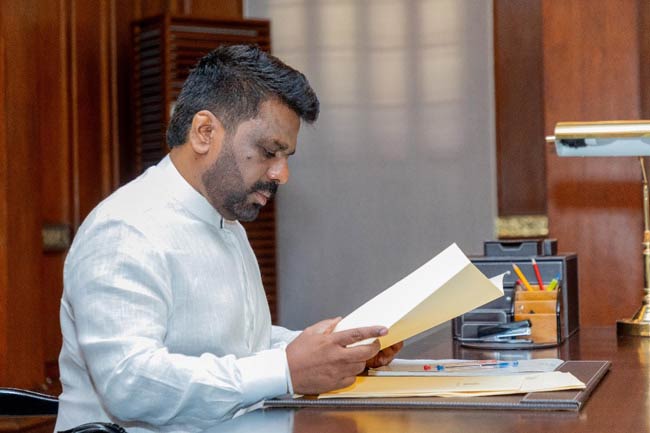
by Rajan Philips
President Anura Kumara Dissanayake has delivered an excellent first budget. It could easily be described as the best budget so far this century and presented in the most dire economic circumstances in Sri Lanka’s modern history. Following his consummate performance in parliament, the President waded into a post-budget forum and joined the country’s economic experts to “dissect new Govt’s maiden budget,” as headlined by the Daily FT, one of the sponsors of the event. Whether one agrees with him or not, there is no question that AKD has been listening to those who knows the subject, has diligently done his homework on the budget file, and knows what he is doing,.
The problem he faces is that he cannot be doing homework on every file for the entire government, and he must find a way to quickly address the collective inexperience of his cabinet. He should not let this inexperience become the enemy that kills the government from within. Hopefully, he will find a way to address this within the framework of the budget and in the delegation of ministerial responsibilities for its implementation.
Somewhere in the budget, the President refers to economic decentralization, to deconcentrate the top heavy Western Province. Unfortunately, the corollary of political decentralization could not find its place in the text. Equally important, the President should also pay attention to ‘cabinet federalisation’ (AJ Wilson’s description of one of DS Senanayake’s quite a few master traits), and more so as he moves ahead to implement the budget proposals.
Ultimately, the success of the budget will be measured in political terms. Read, electoral terms. AKD’s and NPP’s detractors will be winding themselves for political wrestling in the local and later the provincial council elections. The NPP could be expected to hold its ground, but not necessarily all two-thirds of it. It should not at all be strange if the NPP gains ground in the North and East even as it loses some of it in the South. To keep the inevitable losses to the minimum, the government must eschew any and all complacency, which, modifying Mao’s famous Redbook take on it, could be described as the enemy of elections.
Geopolitically, paraphrasing the French Marxist Regis Debray, the NPP government must have its overhead antennas fully alert, but its feet firmly planted on the ground in Sri Lanka. The government cannot avoid being distracted by the global tumults that Donald Trump is creating day in and day out. There will be ripples, even waves, around Sri Lanka depending on what the Modi government decides to do in India to harmonize with the Trump Administration in Washington. Even so, the government’s primary preoccupation in the context of the turmoil in America should be to protect for as long as possible Sri Lanka’s exports to the US which are significant for Sri Lanka’s forex earnings.
At the same time, and consistent with the budget objectives, even as it diversifies its exports the government must diversify its importers. For the next four years, as Trump unfolds his madness, there will be responsive realignments in the Global North even as there will be reconsolidations in the Global South. The NPP government will have to navigate Sri Lanka through these currents without being smothered by them.
There are of course the self-proclaimed Rajapaksa nationalists who want to hitch their broken political wagons in Sri Lanka to the passing hegemon in America. They are in fact ethno-narcissists just like – but writ-small – the racial narcissist that Trump is. Ridiculous as these forces and their politics might seem, indeed as they are, the government should not underestimate their potential to do harm even by accident. Look at Bangladesh to see how political fortunes can dissipate fast, even though the NPP government is in no way comparable to Sheikh Hasina’s rotten government. The eternal home truth is the quick rise and the quicker fall of Gotabaya Rajapaksa.
Setting the Budget Context
The budget speech outlines as its backdrop the 2022 economic crisis that has now become the Rajapaksa era legacy, and as its context the overwhelming verdict of the people in the 2024 presidential and parliamentary elections. In this context, the President calls the budget both “historic” and “challenging,” because the government has to not only lay the foundation for fulfilling the people’s aspirations, but also to dispel “the wrongful picture (of us) created by the myths and malicious political propaganda against our economic policy and vision.” “We have succeeded in that,” the President asserted.
The government has proved its expectant critics wrong and stabilized the economy. All the indicators confirm that – the relatively stable exchange rate at one USD for LKR 300, and not LKR 400 as recklessly scare mongered; the lowering of the Treasury bill rate (8.8%) and getting inflation under control; forex reserves rising past USD six billion; finalizing agreements over debt-restructuring; and most of all keeping essential goods available and avoiding queues. In fairness, the credit for starting the process of economic stabilization belongs to Ranil Wickremesinghe, but post-election expectations in political circles have been that things will start to unravel due to NPP’s inexperience and even incompetence. That did not happen, and President AKD and the NPP government are justified in claiming credit for it.
Mr. Wickremesinghe may have even fancied that another economic crisis this time under an NPP government would give him a second kick at the can of power. No such luck. RW is now part of a team of exes – former ministers and presidents including Maithripala Sirisena – trying to figure out a way to stay relevant in today’s politics. Looking at this aging crowd outside parliament and its slightly younger version in the opposition within parliament, the NPP might fancy its chances of retaining power for more than one cycle of elections. But what the NPP has to contend with ultimately will not be ill equipped politicians but a frustrated electorate.
Apart from President AKD’s versatile feats, the NPP government has little to show to keep the people contented. Recurring rice shortage, the shortfall in coconuts, and the power outage blamed on a monkey tripping off a transformer have certainly taken the shine off the government. Looked from the other end, rice, coconuts and the power outage seem to the only shortcomings that the government is being picked on by media pundits and the political class. But what should concern the NPP government is that any one of them (rice, coconut or power), all of them together, or any similar shortages or failures, are enough to rile the people and bring down a government. Not long ago, it was called aragalaya.
Budget as Political Reset
The budget speech lays down the principles underlying the government’s approach to the economy: sectoral growth sustained by participation and even distribution on the supply side; and balancing roles for the market and the government on the demand side. A GDP growth rate of 5% is targeted for the medium term, predicated on a strong export sector performance while maintaining price stability and ensuring social welfare. Promoting investments, leveraging logistics, revamping tourism, digital transformation of the economy, and unleashing SME potentials through new credit structures are highlighted as the main growth poles. Allocations for health, education, food security, and social benefits are intended to rebuild and strengthen country’s social welfare system.
There is emphasis on Regional Development, including the assurance of special programmes for the Eastern Province, the Malayaga Tamils, and the Northern Province, but there is no mention of Provincial Councils and Local Government bodies and their agency roles in regional development. Regional industrial zones are identified including the promotion of Chemical Manufacturing in Paranthan, KKS and Mankulam in the Northern Province, Galle in the South and Trincomalee in the East. If some of them were to materialize the North and East might be seeing state sponsored industrial activity after more than 70 years when GG Ponnamabalam was Minister of Industries and Fisheries.
Auto Parts and Rubber Products manufacturing is also identified for promotion through industrial zones. What is not clearly indicated is whether new regional industrial initiatives will be tied to the export sector without which they may not be viable, as past experience has shown. Also, on the export front there is no identification of specific products and target markets to match the significant export sector growth that is being championed. Generally, for industries, there should be guardrails for minimizing and mitigating adverse environmental effects.
The budget rightly focuses on the modernization of public transport. Specific projects are identified for bus transport in Colombo and for the rail sector, including the revamping and the extension of the KV Line, multi-modal transport terminal in Kandy, and the expansion of the Thambuththegama Railway Station to function as a hub for transporting agricultural products. Large scale transport projects and rail transport are invariably the responsibility of the central government, but bus transport operations including those in Colombo and Kandy are better assigned to provincial and even larger municipal governments.
The budget provides for settling the legacy debt of the Sri Lankan Airlines (SLA) in the hope that SLA would hereafter become a viable enterprise. For other SOEs, the budget is proposing the setting up of a Holding Company again with the hope of revitalizing the mostly under-performing State Owned Enterprises (SOEs). Whether this approach is motivated by patriotic sentiments or political calculations, there is little support for it from past experience, except for enterprises in the crucial servicing and energy sectors.
The budget gets quite specific in its proposals for the agricultural and food sectors, especially rice and coconuts. At long last, there is official admission at the highest level that there is no data and information system for the “entire value chain” from paddy production to rice consumption. There is no immediate solution to this except the assurance to find one through the ADB funded “Food Security Livelihood Emergency Assistance Project” and a related World Bank project.
Coconuts are easy to count and difficult to hide. Some 4,500 million nuts are the projected demand for 2030, with 2,700 for the coconut industry and 1,800 for household consumption – at one per household per day. The problem is with production and the budget is allocating money for high yielding seedlings to be used in a new Northern Coconut Triangle extending from the coconut rich Northwestern Province, recommended by the Coconut Research Institute and mirror imaging the long established Southern Coconut Triangle. Better later than never, even when it comes to nuts.
All in all, the budget provides a good framework for the NPP government to reset its political road map. To succeed, the resetting must involve delegations at the ministerial level and following through to local communities and political grassroots. Equally important will be the medium in between, and the challenge to the NPP government is in resurrecting and using the currently defunct provincial and local government agencies.
Features
The Murder of a Journalist

By Anura Gunasekera
Commencing with Premakeerthi de Alwis in 1986 and concluding with Lasantha Wickrematunge in 2009, 40 accredited Sri Lankan journalists and media personnel, 31 of them of Tamil, have been murdered or died violently. Of these, 31 occurred between April 2004 and March 2009, during the Mahinda Rajapaksa tenure, initially as Prime Minister and then as President. His younger brother Gotabaya, later president himself, was the Defence Secretary of the country from 2005 to 2015.
During the above period, apart from those killed, many were abducted, assaulted and /or tortured, and intimidated in various other ways. A few left the country in fear of their lives. Most, if not all of those journalists, unsurprisingly, had been vocal critics of the government. With the defeat of the Rajapakse government in 2015, all harassment of journalists ceased, abruptly.
Of the above killings, those of Lasantha Wickrematunge (LW) and that of Richard de Zoysa in 1990, as well as the disappearance of Prageeth Ekneligoda in 2010 are, for a variety of reasons, not least the international outrage and condemnation, considered the most prominent. The most disturbing commonality across all these crimes is that none have been comprehensively investigated and the perpetrators punished.
In fact, despite pointers regarding the identity of the masterminds- circumstantial but compelling – and the very public nature of most of the actual incidents themselves, investigations have been either obstructed or stifled, through intimidation of potential witnesses, misleading autopsies, the enthusiastic pursuit of patently false lines of investigation, deliberately disingenuous official statements and, not infrequently, the suppression or disappearance of physical evidence.
The murder of Richard de Zoysa is again in the limelight on account of the recent film, “Rani”, although any hope of the crime being solved is almost zero. The murder of LW has been publicly profiled in the last few weeks, due to the order for the discharge, by the Attorney General (AG), of three suspects linked to events consequent to the murder, on the grounds of insufficient evidence.
Since the murder of LW, four successive governments have assured the country and the international community, that the case would be comprehensively investigated and those responsible punished. The slain Lasantha Wickrematunge had become an international metaphor for delayed justice. The present NPP government, led by president Anura Kumara Dissanayake, made the investigation of previously unsolved crimes, including that of Lasantha’s murder, and the cleansing of corrupt government systems, a cornerstone of its election manifesto. The sweeping victory of the NPP at the recent general elections was largely due to the faith that the electors placed in those promises.
Why is the case of Lasantha Wickrematunge so important?
Investigative Journalists play a vital role in maintaining a free and open society, by providing the public with critical information, holding power to account and exposing corruption and injustice. In that context, LW played a major role through his paper, “The Sunday Leader” which, week after week, exposed the massive corruption within the Rajapaksa regime, citing specific transactions and quite often linking acts of malfeasance to then President Mahinda Rajapaksa, his brother and Defence Secretary Gotabaya, or to close associates of the Rajapaksa family and the regime.
LW’s silence was worth more to the Rajapaksa family in particular, than to anybody else in the country. In fact, LW’s murder was apparently preceded by an unsuccessful attempt, in 2007, by Mahinda Rajapaksa himself, to broker the sale of the paper to an investor of his choice, the offer being made to Lal, LW’s brother (Page 234- Unbowed and Unafraid- Raine Wickrematunge). The only possible reason for a president of a country to personally seek the divestment of ownership of an outspoken newspaper, is control of its narrative content and direction.
Two years later Lasantha’s assassination paved the way for the exercise of this option.
In Sept 2012, businessman and alleged Rajapakse associate, Asanga Seneviratne, many of whose property development and investment deals had been criticized at various times by the “Leader”, bought a 72% stake in the “Leader” and its sister newspaper, “Iruresa”. In the same month Frederica Jansz, then editor of the “Leader” and long-time colleague of LW, was summarily dismissed from her position. In May 2015 the “Leader”, now under a decidedly Rajapaksa-friendly dispensation, tendered an unconditional apology to Gotabaya Rajapksa for a series of articles it had run, during LW’s tenure as editor, on the indisputably questionable method of purchase of MiG-27 aircraft from Ukraine, for the Sri Lanka Air Force. Udayanga Weeratunga, relative of the Rajapaksa family, as then Sri Lanka’s ambassador to Ukraine, allegedly played a major role in facilitating the said transaction. According to Ahimsa, LW’s daughter, LW was on the verge of exposing the highly complex and sordid details of the deal in entirety, when he was murdered (The MiG deal; Why My Father Had To Die- Groundviews-01/08/21).
The above is just one of the hundreds of expose’s featured by LW and he very rarely got it wrong. Very few other journalists in recent decades – the late Victor Ivan was one other- so courageously and in such minute detail, addressed the sins of those in power as LW did. They were issues that many journalists avoided, a self-regulation on truthful journalism brought about as a conditioned survival mechanism, in response to the brutal repression of those who dared to write the truth about power.
LW’s last writing- “Then They Came For Me”– published posthumously and now a classic of Asian journalism, was a chillingly prophetic prediction of his own death, pointing an accusatory finger at his erstwhile friend, then president Mahinda Rajapaksa.
The death of any human being diminishes society but the death of a fearless journalist, who holds a mirror to the foibles of society and power, diminishes our world in a special way; especially a world such as ours where leaders, irrespective of political colour, have proved to be treacherous, unreliable, corrupt, mercenary and nepotistic.
On the 27th of January, Parinda Ranasinghe Jr, Attorney General (AG) of Sri Lanka, ordered the release – citing lack of evidence to proceed with indictments – of Ananda Udalagama, implicated in the abduction in August 2009 of Karunaratne Dias, LW’s driver, and DIG Prasanna Nanayakkara and Sub-inspector Sugathapala, both implicated in the disappearance of a notebook recovered from LW’s vehicle after his murder. Consequent to immediate and widespread criticism and physical demonstrations against this order, it has since been rescinded.
In this episode the primary, indisputable principle, is that it is entirely at the AG’s discretion, to decide whether or not to charge a suspect, taking in to account the validity of admissible evidence available, and the prospect of securing a conviction. The political body has no right suggest a review of such a decision, or to compel the AG to consider such a review, irrespective of the importance of the case. At the same time it is also assumed that the AG and his department will carry out their duties impartially, irrespective of past loyalties – if any – and current personal prejudices, especially in relation to sensational cases involving those previously and currently in power.
Assuming that the release order was issued after a comprehensive analysis of the available evidence, the subsequent reversal is baffling, to say the least. Is it that the AG, or the legal officers responsible, consequent to a re-assessment of available material, suddenly realized that they had a made a serious error of judgment? Or did the AG’s department cave in to political and public pressure and decide to change its decision?
If the AG had braved both public and political displeasure and held fast to the original decision, it would have been perfectly acceptable and even commendable. However, it is now being reported in responsible mainstream newspapers, that the rescinding of the original decision is a response to a request by the Criminal Investigation Department (CID), to give it more time to act on the AG’s order, on account of the controversy surrounding the issue. The official version now appears to be that what is now in place is a suspension of the original decision, and not a reversal.
In the meantime, Ahimsa, through her publicized letter of February 14 to Anura Meddegoda, President of the Bar Association of Sri Lanka, has censured him for his hypocritical support of the AG and his position in this episode. She has supported her position by reference to Meddegoda’s protest against a similar order by the AG, under very similar circumstances, when it involved the murder of one Indika Prasad, allegedly by members of the Special Task Force. The interests of the victim’s wife were represented by Meddegoda.
Ahimsa has condemned the AG’s position in this matter, in the said letter citing seemingly convincing evidence available against the three suspects named earlier. She has even called for the impeachment of the AG, on the grounds that in ordering the discharge of the suspects, he has deliberately chosen to ignore vital evidence.
For an ordinary citizen such as the writer, with only a minimal understanding of criminal law, an analysis of the legal validity of the AG’s management of the case in question is not possible. But, still, to the writer and to several million other citizens who helped to bring the NPP in to power, the delivery of justice in matters of public corruption, politically motivated murders and similar crimes, are issues of supreme importance.
Fearless journalists such as Lasantha Wickrematunge paid with their lives for their reportage and public exposure of the crimes of the politically powerful. The justice for such crimes is owed, not only to the family members of the slain, but to the nation itself. It ceased to be a private, Wickrematunge family project a long time ago.
President AKD has steadfastly maintained that his regime will not interfere with ongoing legal processes, unlike previous regimes which seemed to often guide the hand of the law, in cases which featured those in power, unfavourably. However, what may be prudent and necessary, if justice is to be finally done, is intervention and course correction at critical stages, to ensure that public officers entrusted with relevant responsibilities do not lose sight of both the principle and the objective.
Features
My Dog Tosca
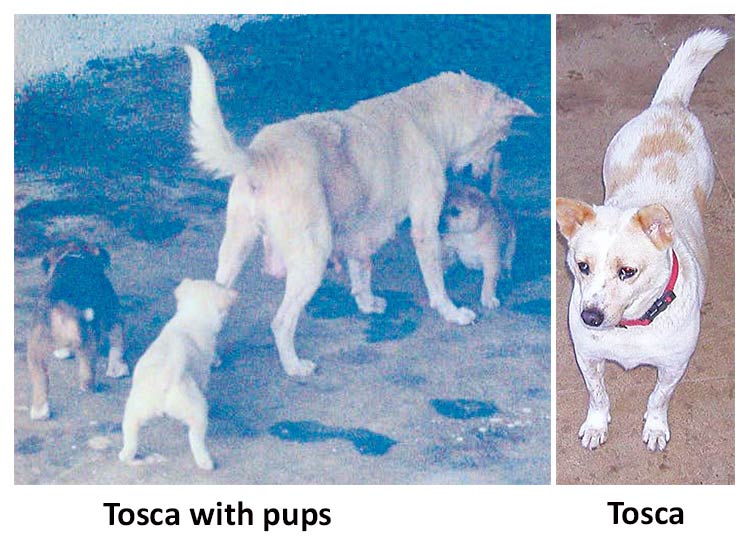
My Dog Tosca
Michael Patrick O’Leary
We did not delude ourselves that we owned her. My title is a reference to JR Ackerley’s memoir, My Dog Tulip. JR Ackerley was adistinguished British man of letters. His dog was, in reality, a German Shepherd called Queenie. My Dog Tulip is an account of their sixteen-year companionship, as well as a meditation on the peculiarity of all relationships.
When we first moved to Sri Lanka in 2002, we rented a large plantation bungalow on the outskirts of Bandarawela in Uva province in the hill country. There were four huge bedrooms each with a large bathroom containing a deep bath with cast iron ball and claw feet. We strongly suspected that the house was haunted, but that is material for another article.
I noticed Tosca on my way to the kade. She had a horrible abscess hanging out of one eye but had a very benign expression. Dogs are not supposed to smile but she seemed to do so, beatifically. She seemed to take to us and, somewhat nervously, started approaching our house. One night we noticed her sleeping in a drain near the house and she was not alone. A female companion, who later became known as Daisy, was huddling with her for warmth.
We gradually adopted these two as our own, although we could not delude ourselves that we owned them.
Unfortunately, Tosca, in particular, became prey to the rampaging males of the area and was often subjected to gang-rape. One rather timid fellow we named The Suitor, was in flagrante when Hendrick, a disreputable one-eyed old roué of an ageing rock star who lived on the estate and considered he had prior rights, urinated on The Suitor in mid-coitus. Some people pay good money for that in Moscow hotels (allegedly).
The result of all this male attention was a litter of pups. One very small black and tan one died soon. Two of them were later found homes and given the names Lucky (a bad choice) and Sando (I had called him Tufton Bufton). More of those later. Silky remained with us and moved to a new with us.
When the pups were first born, Tosca was perhaps not an ideal mother. One got the feeling that she thought a different kind of life was her due. She remained rather plump after the pregnancy and she reminded me of one of those 1950s blonde pneumatic movie stars like Mamie van Doren or Jayne Mansfield (I’m showing my age here, readers). She would often abandon the pups and come to hide from them with us in the sit-out around the back of the house. The little monsters always managed to find her and squawk and bite and scratch at her abused undercarriage.
Luckily, we knew a good vet and she was able to perform surgery at our home to remove the abscess from the eye and to sterilise Tosca. A lot of veterinary attention was needed. On one occasion, she seemed very ill and was hiding in the bushes. The vet thought she might have been poisoned. We took her to the Veterinary Faculty at Peradeniya University in Kandy, where she was admitted for observation. Tosca loved motor travel. In fact, she demanded to get in the car whenever we went shopping. Children looked in and told their parents there was a beautiful dog in the car. She serenely took such compliments as her due. If she saw another dog passing by she would bark at it imperiously.
The journey to Peradeniya was not too difficult, but Tosca clearly did not think the accommodation at the veterinary faculty was up to the standards to which she had become accustomed. When we went to collect her after six days she was very huffy and walked briskly to a white car and demanded to be let in. Unfortunately, it was someone else’s car.
When we moved to our own house, Tosca, Daisy, Hendrick and Silky came with us. The intricate social dynamics of this ménage, particularly the antics of Tosca and Daisy in their lesbian love nest, must be the subject for another article (or scholarly thesis or porn movie). We retrieved Sando from his adoptive parents. He was no longer the grumpy fellow we had known before. He was now a perfect gentleman, which caused Silky to bully him mercilessly.
Tosca continued to enjoy her status as motor-mutt with the bonus of long walks through the tea estate and mud-baths, the dirtier the better. She is no longer with us. Like most street dogs, she once had a home with humans who abandoned her. She endured with dignity. She survived a long time after being diagnosed with mouth cancer. I am not ashamed of appearing sentimental when I say that I hope we added something to her life.
In the New York Review of Books, Catherine Schine reviewed an animated movie version of JR Ackerley’s memoir My Dog Tulip.
“What strained and anxious lives dogs must lead, so emotionally involved in the world of men, whose affections they strive endlessly to secure, whose authority they are expected unquestionably to obey, and whose mind they never can do more than imperfectly reach and comprehend. Stupidly loved, stupidly hated, acquired without thought, reared and ruled without understanding, passed on or ‘put to sleep’ without care, did they, I wondered, these descendants of the creatures who, thousands of years ago in the primeval forests, laid siege to the heart of man, took him under their protection, tried to tame him, and failed—did they suffer from headaches?”
(“Michael Patrick O’Leary is an Irish citizen who has lived in Sri Lanka with his Sri Lankan wife since since 2002.
More of his writing can be found on Substack. Please subscribe . It’s free! https://moleary.substack.com)
-
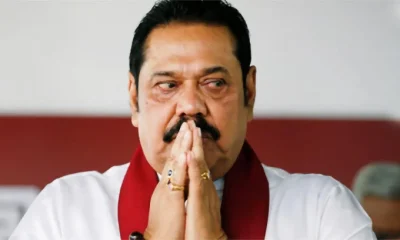
 Features6 days ago
Features6 days agoDon’t betray baiyas who voted you into power for lack of better alternative: a helpful warning to NPP – II
-

 News4 days ago
News4 days agoCommercial High Court orders AASSL to pay Rs 176 mn for unilateral termination of contract
-
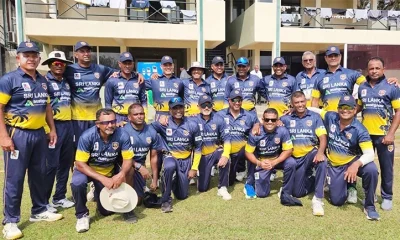
 Sports3 days ago
Sports3 days agoSri Lanka face Australia in Masters World Cup semi-final today
-

 Features6 days ago
Features6 days agoTwo films and comments
-
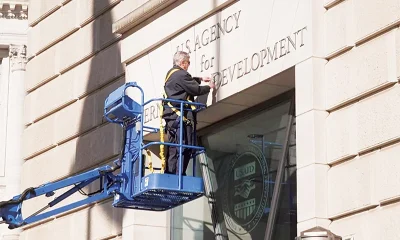
 Features5 days ago
Features5 days agoUSAID and NGOS under siege
-
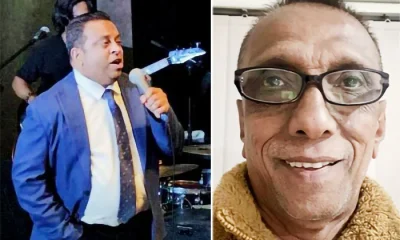
 Features5 days ago
Features5 days agoDoing it in the Philippines…
-

 News3 days ago
News3 days agoCourtroom shooting: Police admit serious security lapses
-
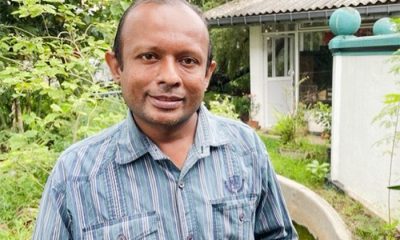
 News4 days ago
News4 days agoFSP lambasts Budget as extension of IMF austerity agenda at the expense of people

